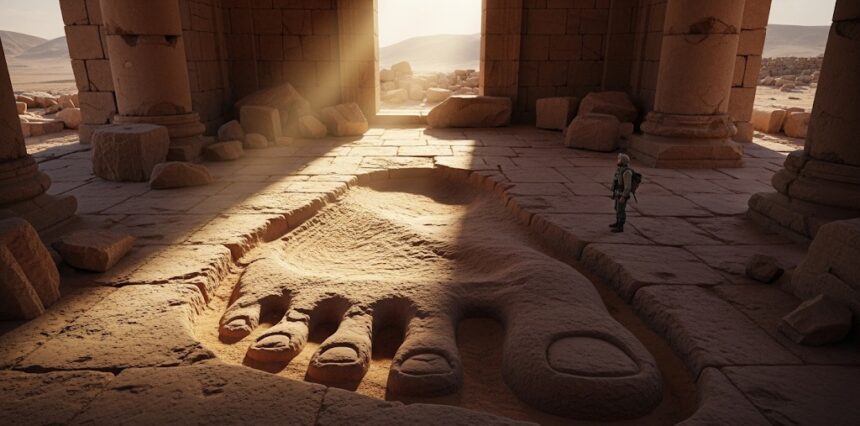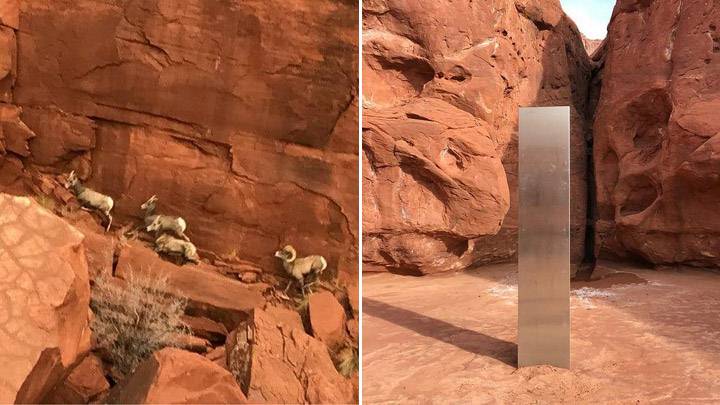For most of us, stories of giants belong in fairy tales. We read about them in childhood, dismiss them as myth, and move on. Yet, in the sun-baked sands of Syria, a fascinating and unnerving puzzle is being unearthed—one that points not to folklore, but to a very real, very tangible history of a race of giants. This isn’t a fantasy; it’s an archaeological bombshell, a biblical riddle, and an anthropological shockwave all rolled into one. At the heart of this mystery lies the Rephaim, a shadowy people often described as the children of “gods” and mortal women.
Could these ancient accounts be more than just stories? Is it possible that the Rephaim, or a race like them, once walked the Earth, leaving behind traces so immense they defy modern explanation?
Proof No. 1: Abel’s Tomb and the Giant Sarcophagus
Our journey begins at the Nabi Habil (Nabi Abil) mosque, a sacred site for Shiite Muslims located just 30 kilometers from Damascus, Syria. This location, believed to be the biblical city of Avila, is revered as the resting place of Abel, the second son of Adam and Eve.
The most striking feature inside the mosque is not a fresco or an ornate dome, but a massive granite sarcophagus that serves as Abel’s tomb. It measures a staggering 7 meters long, with some accounts even claiming it to be up to 10 meters. To put that in perspective, a modern human coffin is typically around 2 meters long. The sheer size of this monument is beyond doubt for the millions of pilgrims who visit the site. For them, it’s a silent testament to the belief that Abel and the first generations of humanity were giants.
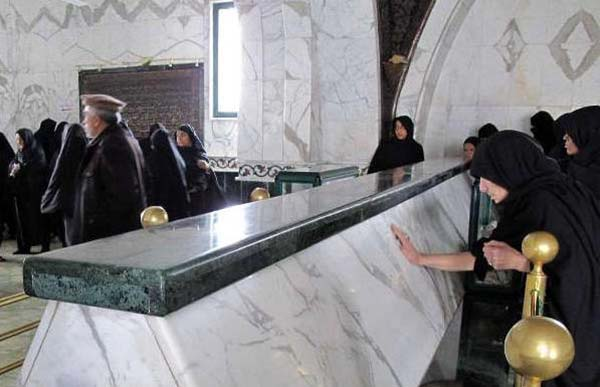
The significance here is profound. This is a centuries-old practice of faith, deeply embedded in the sacred geography of the region. The mosque stands on a site sanctified by the very first murder on Earth, and the scale of the tomb is a silent, stone witness to the immense stature of its participants.
Proof No. 2: The Temple of Ain Dara and the Footprints of a Giant
Next, we travel to the remote ruins of the Temple of Ain Dara, a breathtaking site from approximately 3000 BCE near the Turkish border. What was found here on the stone floor of the temple challenges our understanding of who built these ancient structures.
Embedded in the rock are two colossal depressions, each perfectly shaped like a bare human foot. The length of each print is an astonishing 130 centimeters (1.3 meters). For comparison, the average adult human foot is about 30 centimeters.
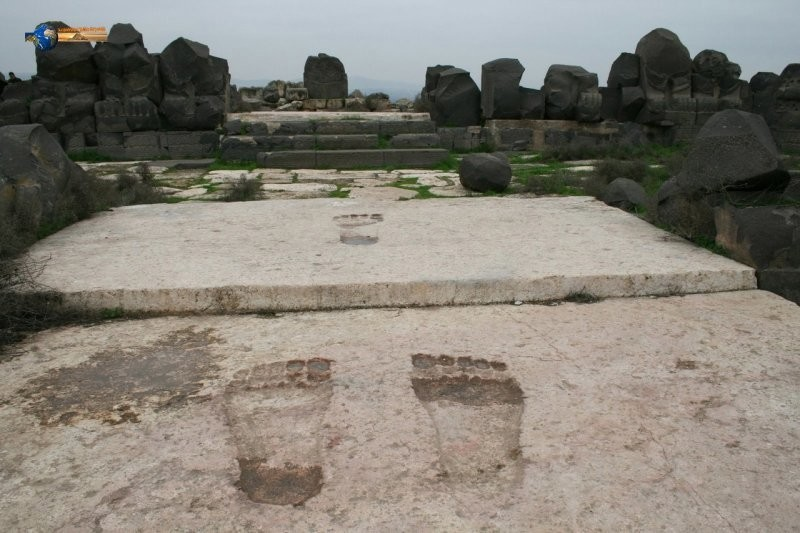
This is not a stylization or a hoax. Such a mark could only be left by the bare foot of a man. It was not carved in stone, it was not handmade. On this cement, all the nuances of the structure of the foot are drawn.
Based on human body proportions (foot length is roughly 15% of total height), scientists calculated that the being who left these footprints would have stood an incredible 10 meters tall and weighed an estimated 3.5 tons. The footprints themselves are arranged in a way that suggests the giant first stood still, then pushed off, and made several enormous leaps across the temple courtyard.
The temple itself adds another layer of mystery. It was built from gigantic slabs of black basalt on the top of a mountain. The nearest basalt outcrops are over 600 kilometers away. Even with modern technology, transporting such massive, multi-ton blocks would be a difficult engineering feat. This has led to a shocking hypothesis: Perhaps the basalt was chosen for its special properties, and its transportation was a feasible task for the giant builders themselves or their “divine” patrons.
Biblical Chronicles: The Rephaim in Ancient Texts
The search for the Rephaim doesn’t end with archaeology; it’s deeply rooted in some of the oldest texts known to man. The Bible and other ancient apocryphal works are full of references to giants who inhabited the Earth.
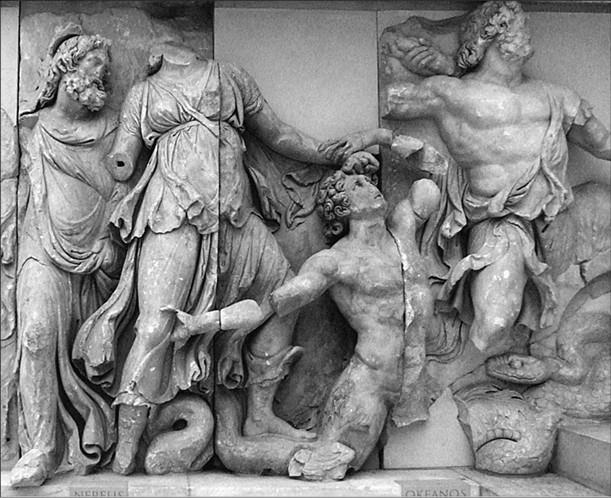
The Nephilim and Their Descendants
- Genesis 6:4: “The Nephilim were on the earth in those days—and also afterward—when the sons of God went to the daughters of humans and had children by them. They were the heroes of old, men of renown.” This verse introduces the Nephilim—a race of “mighty men” born from the union of “sons of God” (often interpreted as fallen angels or divine beings) and mortal women. The Rephaim are frequently identified as their descendants.
- Numbers 13:33: When Israelite spies reported back from Canaan, they were terrified. “We saw the Nephilim there (the descendants of Anak come from the Nephilim). We seemed like grasshoppers in our own eyes, and we looked the same to them.” This quote captures the terror and immense scale of these giants from the perspective of ordinary humans.
King Og and the Iron Bed
- Deuteronomy 3:11-13: This passage directly names the Rephaim as an ancient people of giants who lived east of the Jordan River. It describes the bed (or sarcophagus) of King Og of Bashan, a powerful Rephaim ruler: “His bed was an iron bed, and it is in Rabbah of the Ammonites; nine cubits is its length, and four cubits is its breadth.” That translates to approximately 4.5 meters long and 2 meters wide, a colossal size that further reinforces the idea of a giant race.
Polydactyly: A Genetic Marker?
- 2 Samuel 21:20 and 1 Chronicles 20:6: These verses describe a battle where a giant from Gath was killed. The text specifies: “He had six fingers on each hand and six toes on each foot—twenty-four in all. He was also a descendant of Rapha.” This shocking detail—polydactyly, or having six digits—is explicitly stated as a characteristic of the Rephaim.
This detail has a bizarre and fascinating parallel in legends from around the world. The Native American Paute tribe, for instance, has vivid stories of wars against red-haired giants (the Si-Te-Kahs) who were 3-4 meters tall and also had six fingers. The Indian greeting of a raised palm is said to have originated as a way to show “I have five fingers, I am not a giant!”
The Enigma of the Rephaim: Who Were They?
So, who were these colossal beings? The evidence from the Syrian desert, coupled with global myths and ancient texts, presents several compelling hypotheses, each more thought-provoking than the last.
1. Children of Fallen Angels
This is the traditional biblical-apocryphal version. “The sons of God” were angelic beings who descended to Earth, interbred with human women, and gave birth to a hybrid race of ungodly giants. Their wickedness led to the Great Flood, and the Rephaim are seen as either the survivors or a subsequent generation of these beings.
2. Alien Hybrid Offspring
A more modern interpretation suggests that the “sons of God” were actually highly advanced extraterrestrial beings whose technology was mistaken for divinity. The Rephaim, in this view, were their hybrid offspring, genetically engineered with superhuman strength and potentially advanced knowledge. This hypothesis could explain their connection to the “heavens,” the mysteries behind incredible megalithic structures like Baalbek, and their eventual extermination as a threat to humanity.
3. Remnants of a Pre-Deluvian Civilization
This hypothesis posits that the Rephaim were not hybrids but simply representatives of a much older, possibly more developed civilization that existed before the rise of modern humanity. This antediluvian society might have been characterized by people of gigantic stature, who were either destroyed by a global cataclysm or gradually died out.
4. The Skeptical View: Exaggerations of Gigantism
The scientific community’s most common explanation is that the Rephaim are the result of ancient exaggerations of rare medical conditions like gigantism or acromegaly. However, this theory falls short when faced with the hard evidence. It doesn’t explain the enduring legends of entire peoples of giants, the massive scale of Abel’s 7-meter sarcophagus, or the 130-centimeter footprints found in the Temple of Ain Dara. A medical condition doesn’t produce artifacts of this scale. It also fails to account for polydactyly being a recurring, specific racial trait in both ancient texts and global legends.
The Rephaim: A Challenge to Our Understanding
The footprints in the stone of Ain Dara, the colossal sarcophagus of Abel, and the specific biblical chronicles of King Og and Goliath all add up to a mosaic that can no longer be ignored. Syria, as the ancient heartland of Canaan, seems to be the very epicenter of this mystery. The Rephaim have transcended myth and become a genuine historical and archaeological problem.
The evidence suggests they were real. They were enormous. And they left an indelible mark on the landscape and in the collective memory of humanity.
But the most haunting questions remain unanswered:
- Who were their fathers? Were they fallen angels, advanced aliens, or the last remnants of a forgotten terrestrial civilization?
- What knowledge did they possess? Were cyclopean structures like Baalbek truly the work of their hands? Did they wield technologies that seemed like the “magic of the gods” to our ancestors?
- Why did they disappear? Were they exterminated by humanity, as some legends claim? Did they perish in a cataclysm, or were they simply assimilated, leaving only traces in the bloodlines of a few?
The sand of Syria continues to hold its secrets. But one thing is now abundantly clear: the history of humanity is far older, more complex, and more fantastical than we ever dared to imagine. The Rephaim aren’t just a fairy tale. They are a challenge to our science, our faith, and our very understanding of ourselves. They are ghosts whose gigantic shadows still fall upon us from the depths of millennia, demanding an answer.







